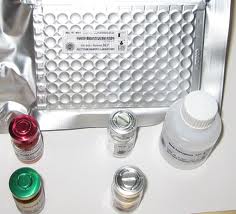
Product name:Holo-transferrin
CAS:11096-37-0
Specification:10MG
Description:
Transferrin is the iron-transport protein of vertebrate serum and donates iron to cells through interaction with a specific membrane receptor, CD71. Transferrin appears to be indispensable for most cells growing in tissue culture.
It is referred to frequently as a growth factor because, in analogy to other growth factor-receptor interactions, proliferating cells express high numbers of transferrin receptors, and the binding of transferrin to their receptors is needed for cells to initiate and maintain their DNA synthesis. Apart from its role as an iron transport protein transferrin acts as a cytokine and has functions that may not be related to its iron-carrying capacity.
Holo-transferrin is the main ferritin in plasma, which provides iron for intracellular differentiation and metabolism. It has been found that transferrin is indispensable to all cell growth. Not only does maintaining normal cell metabolism depend on iron in a biologically active form, iron is also a cofactor of some enzymes, such as RNA polymerase and DNA synthase. It is also an important component of hemoglobin.
Transferrin is a class II transmembrane glycoprotein family which widely exists in vertebrate body fluids and cells. There are three types of transmembrane glycoproteins: serum transferrin, ovotransferrin and lactotransferrin. Different types of transferrins have different physical, chemical and immunological properties, but they all have two trivalent iron binding sites. These substances are abundant in human blood vessels and are indispensable components in body fluids. They are not only involved in the transport and metabolism of iron, in the regulation of respiration, cell proliferation and immune system, but also in the regulation of iron ion balance and energy balance. They have more antimicrobial and bactericidal protective functions and are safe and non-toxic than most chemotherapeutic drugs. There are obvious advantages. This product can assist plasma glycoprotein to transport iron ions to normal cells. Tumor cells need more iron ions than normal cells. Therefore, this substance has been used as a drug carrier for targeted therapy of tumors. This product is a single-chain glycosylated protein with about 6% glycosyl group. It consists of two highly homologous domains, N-terminal and C-terminal. Among them, there are 8 N-terminal domains and 11 disulfide bonds in C-terminal domains, which play an important role in maintaining the conformation of proteins. It can not only stabilize the internal structure of secondary and tertiary peptide chains, but also mediate them. The formation of the four-level structure between the peptide chains.

